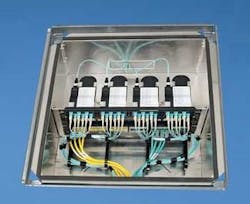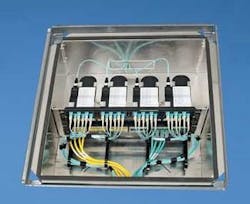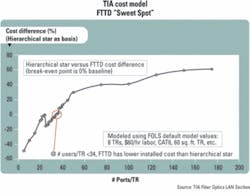FTTD can be cost effective, industry insiders say
by Meghan Fuller Hanna
Fiber to the desktop (FTTD) has always been a Holy Grail for fiber manufacturers, but it remains a niche application, largely due to fiber’s perceived high cost. But network installers should not shy away from fiber, says TIA’s Fiber Optic LAN Section (FOLS-www.fols.org). The group has developed a cost model that proves FTTD can be more cost-effective than copper in the right situation.
Robert Reid, product development manager at Panduit Corp. (www.panduit.com) and member of the TIA FOLS, developed the cost model using historical values typical of an enterprise network. His model assumes that the typical enterprise hierarchical star network includes eight telecom rooms (TRs), employs Category 6 cable, and requires roughly $60 per hour in labor construction costs.
In the hierarchical star architecture, fiber is run from the main equipment room to the TR(s) on each floor. Copper cabling is then run from the TR out to the workstation or desk. A centralized fiber or FTTD architecture, by contrast, features homerun fiber from the TR all the way out to the desk.
Reid then developed a graph (see fig. page 30) to chart the cost difference between the hierarchical star architecture and centralized fiber as a function of the number of ports or users per TR. Varying the number of users per TR, Reid found that FTTD has a lower installed cost versus hierarchical star with 34 or fewer users per TR.
Reid explains that part of these cost savings results from reducing the size of the TR or even eliminating it entirely. The TIA’s cost model uses a default value of 60 sq. ft. In other words, the typical TR is a 60-sq.-ft. or a 6×10-ft room. A centralized fiber or FTTD architecture, by contrast, often requires just a 6-sq.-ft. closet, or 2×3 ft. A reduction in the size of the TR will, in turn, result in lower construction costs and a reduction in heating, cooling, and maintenance costs.
“It’s also a very strong function of how expensive your floor space is,” says Reid. “If I have very expensive floor space, fiber to the desk becomes more attractive because I don’t have to have a TR in the traditional sense. People don’t think about that; they just look at the transceivers, the fiber and copper, and they say, ‘Fiber is more expensive,’” he muses. “But you really have to look at the full bill of materials for the infrastructure.”
But the FTTD message seems to be slow in filtering into the network installer community. Reid believes FTTD will continue to be a niche application, and he says that’s more a function of the mindset of the network installers than the technology itself. “If we had installed FDDI-grade fiber across all these installations in the 1980s instead of three iterations of copper,” he says, “if you look at life cycle costs, we probably would have saved a lot of money because we’d still be using that fiber today. In a lot of cases, it’s a lack of understanding of the true costs of the job.”


